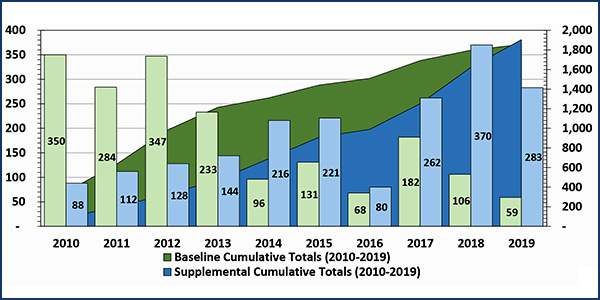A proposal to open end-of-life (EOL) transmission projects in PJM to regional planning and competitive bidding was narrowly defeated in a vote at the Markets and Reliability Committee meeting Thursday.
The “joint stakeholders” proposal from American Municipal Power (AMP), Old Dominion Electric Cooperative (ODEC) and others failed with a sector-weighted vote of 3.23 (65%). The proposal needed a sector-weighted vote of 3.33 (66.7%) for passage.
The proposal won support from 100% of the End-Use Customers, 97% of the Electric Distributors and 71% of Generation Owners. But it was opposed by 59% of Other Suppliers and all but two of 14 Transmission Owners.
Transmission owners would have been required to notify PJM and stakeholders of any facility nearing the end of its life at least six years before its retirement date so that the project could be included in five-year planning models and potentially opened to competitive bidding. It would also modify the supplemental project definition to exclude EOL projects, which would become a new category of regionally planned projects.
A proposal by PJM also failed with a sector-weighted vote of 1.77 (36%) at the MRC.
Despite failing at the MRC, supporters of the joint stakeholders proposal unsuccessfully attempted to bring it to a vote at the Members Committee meeting in the afternoon after Chair Steve Lieberman, of AMP, recused himself from the meeting.
After about 90 minutes of parliamentary jousting, the stakeholders called a vote to suspend the rules to allow consideration of their proposal, but the motion fell short of the two-thirds needed with a vote of 3.08 (62%).
ODEC’s Mark Ringhausen, who presented the joint stakeholder package, said it would allow for Order 1000 competition in EOL projects that would ultimately lead to lower costs for ratepayers.
Ringhausen highlighted the TOs’ May 7 notification that they were considering a Federal Power Act Section 205 filing to amend the Tariff as an alternative to the proposals under consideration. Ringhausen said the TO filing at FERC after June 8 would be similar to the PJM proposal, which had “almost zero transparency,” giving the TOs control over most of the future transmission planning.
Dave Souder, PJM’s senior director of system planning, presented the RTO’s package, which would have required TOs to have a formal program for EOL determinations and to identify potential EOL projects five years in advance. Projects that “overlap” with RTEP violations would be included in a competitive window seeking regional solutions.
PJM cited language in the Consolidated Transmission Owners Agreement (CTOA) that allowed TOs to retain the authority to “build, finance, own, acquire, sell, dispose, retire, merge or otherwise transfer or convey all or any part of its assets, including any transmission facilities.” The RTO also said its role was limited by two FERC rulings involving ‘Asset Management’ not Subject to Order 890, FERC Rules.)
“At the end of the day, we’re going to have to agree to disagree,” Ringhausen said of the stakeholders’ insistence that their proposal complies with the CTOA and the PJM Tariff. “Hopefully, we can get this in front of FERC and make them look at it and say what the right outcome should be here for this process.”
Mike Gahimer of the Indiana Office of Utility Consumer Counselor said PJM “misrepresented” the FERC orders. In the order involving Southern California Edison, Gahimer said, FERC stressed the limited scope of asset management as “looking at components, not entire substations or transmission lines for replacement.”
Gahimer said the joint stakeholder proposal didn’t involve components, but rather lines and substations. “I don’t think anyone, including the most biased among us, would claim that the projects at issue here are day-to-day projects,” he said.
AMP’s Ed Tatum said that with the amount of transmission infrastructure that’s going to have to be replaced in the next decade, careful planning is going to be needed. He said PJM’s expertise is essential to ensure that the planning for the grid of the future is simply not rebuilding the transmission system of the past. He fears the future of transmission planning will be moved out of the jurisdiction of PJM and back to the TOs without coming up with compromises.
“That’s a great concern from the standpoint of those who believe transmission and an independent transmission planner is a cornerstone to competitive markets,” Tatum said. “We think that PJM should be the independent planner. We think they bring value from a more holistic look.”
Thursday’s votes are unlikely to bring an end to the billion-dollar debate over control of EOL projects.
The TOs have scheduled a webinar from 2 to 4 p.m. Monday to discuss their potential Attachment M-3 filing. They could file the attachment after the 30-day comment period expires June 8.
Supporters of the joint stakeholders proposal could file a complaint with FERC contending the current procedures are not just and reasonable.





